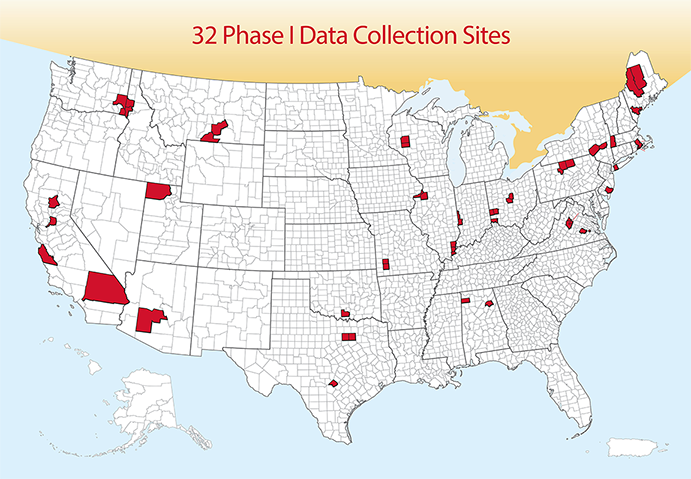What It Is
The National Highway Traffic Safety Administration has collected crash data since the early 1970s to support its mission to reduce motor vehicle crashes, injuries, and deaths on our Nation’s highways. NHTSA’s crash data collection program consists of the Crash Investigation Sampling System, the Fatality Analysis Reporting System, the Crash Report Sampling System, Special Crash Investigations, Non-Traffic Surveillance, the Crash Injury Research & Engineering Network, and special studies conducted to address various safety topics. The CISS builds on the retiring, long running National Automotive Sampling System Crashworthiness Data System. CISS collects detailed crash data to help scientists and engineers analyze motor vehicle crashes and injuries. CISS collects data on a representative sample of minor, serious, and fatal crashes involving at least one motor vehicle in transport on a trafficway.
How It Works
After a crash has been sampled, trained Crash Technicians obtain data from crash sites by documenting scene evidence such as skid marks, fluid spills, and struck objects. They locate the vehicles involved, document the crash damage and identify interior components that were contacted by the occupants. On-site inspections are followed-up with confidential interviews of the crash victims and a review of medical records for injuries sustained in the crash. CISS uses emerging technologies and methods to acquire quality data.
The Crash Technicians are interested only in information that will help them understand the nature and outcome of the crashes.
Personal information such as names, addresses, license and registration numbers, and even specific crash locations are not included in public CISS files.
Sampling
CISS randomly selects thousands of police crash reports at law enforcement agencies in selected areas across the country. The areas reflect the geography, population, miles driven, and crashes in the United States. To be eligible for the CISS sample, a crash must involve at least one towed passenger vehicle.

Cooperation
CISS depends on the participation and cooperation of law enforcement agencies, hospitals, physicians, medical examiners, coroners, insurance companies, salvage facilities, tow yard operators, repair shops, and the people involved in crashes.
Cooperation from law enforcement agencies enables CISS to list and select crashes to be studied. Police crash reports – which provide key information on the location of the crash, the vehicles involved, and where the injured were taken for medical care – are obtained and treated as confidential documents. Law enforcement agencies also permit access to certain roadways and crashed vehicles.
NHTSA is recognized by the Department of Health and Human Services as a Public Health Authority, allowing the medical community to provide access to its records. Medical records are the primary source of data on the nature and severity of injuries.
Tow yards, repair facilities, and impound lots provide access to damaged vehicles. CISS Crash Technicians photograph vehicles at these sites, measure vehicle damage, document safety systems, and record the sources of occupant injury.
Confidential interviews with victims who were involved in crashes provide crash details, insights into how crashes occur, the extent of injuries, treatment received, safety system performance, and work time lost.
Collectively, information from these sources provides a detailed picture of a crash – from just before the crash through medical care received by the injured.
How the Information Is Used
The data collected by the CISS field teams is used by NHTSA and others for a variety of purposes:
- Identifying existing and emerging highway safety problems.
- Obtaining detailed crash performance data for passenger vehicles, including the vehicle safety systems and designs.
- Learning more about the nature of crash-related injuries and the relationship between the type and severity of a crash and the resulting injuries.
- Assessing the effectiveness of motor vehicle standards and highway safety programs.
After all personal identifiers are removed, information collected by CISS is made available to other Federal agencies; state and local governments; universities; research institutions; automobile, trucking, and insurance industries; and the general public.
More Information
For more information on CISS technical operations and field procedures, contact:
National Highway Traffic Safety Administration
National Center for Statistics and Analysis
Crash Investigation Division, NSA0110
1200 New Jersey Avenue SE
Washington, DC 20590
For statistical publications and information, case data, or data files, contact:
National Highway Traffic Safety Administration
National Center for Statistics and Analysis
Data Reporting and Information Division, NSA0230
1200 New Jersey Avenue SE
Washington, DC 20590
You can also ask for more information or make requests to either office by phone or email.
VEHICLE SAFETY HOTLINE
Do you need information on auto safety recalls, crash test results, or fuel economy ratings? Do you have a complaint about a possible motor vehicle safety defect?
Call the Vehicle Safety Hotline, toll-free: 888-327-4236
OMB Control Number: 2127-0706
Expiration Date: 08/31/2025
